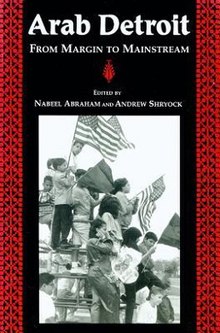Arab Detroit

Arab Detroit: From Margin to Mainstream is a book published by Wayne State University Press in 2000, edited by Nabeel Abraham and Andrew Shryock. It discusses the Arab population in Metro Detroit.[1]
The book's subtitle refers to the question of whether Arabs in Metro Detroit have joined the mainstream American culture and society or whether they are still marginalized.[2]
Background
It originated from Creating a New Arab World: A Century in the Life of the Arab Community in Detroit, a 1994 project of the
Contents
The volume includes over 30 essays, articles, poems,[2] and memoirs.[4] If the introductions are included, there are a total of 39 entries.[5] They are divided into six sections, each with an introduction: Qualities/Quantities, Work, Religion, Politics, Life Journeys, and Ethnic Futures.[5] While each section has a theme, certain themes cross-over into different sections.[6] The editors wrote the introductions.[3]
Victoria Bernal of University of California, Irvine wrote that many of the essays are personal reflections, and a reader may not understand the personal context. Therefore, she recommended reading the final section of the book, "Family Resemblances: Kinship and Community in Arab Detroit" by Shryock, first.[5] Bernal stated that non-specialists, including university undergraduates, would easily understand the book due to a lack of jargon.[7]
Reception
Bernal wrote that the book "has accomplished an important task in laying the groundwork for future studies of Arab communities in Detroit and elsewhere in America."[7] Bernal argued that many readers may not understand the wider context of the Arab experience since so much material is related to individual families. She also stated that the editors rarely discuss reasons why Americans may be hostile to Arabs,[8] and that the "culture of racism" of the term "Americanization",[9] used in the book "as if this was unproblematic",[8] was not examined.[8]
James Goode of Grand Valley State University wrote that the book's editors "have made an important contribution to immigrant studies, while providing a work that is easily accessible to the general public."[10]
Garbi Schmidt of the Danish National Institute of Social Research wrote that Arab Detroit "is a book well worth reading".[11] Schmidt argued that in some cases the authors did not adequately explain their perspectives and choices of subjects, and he also stated that the book should have explored inter-ethnic relations within the Muslim community.[11]
Sridevi Menon of Bowling Green State University wrote that the book is "an exceptional portrait of a vibrant "ethnic" community."[12]
References
- Bernal, Victoria (University of California, Irvine). "Arab Detroit: From Margin to Mainstream." Journal of American Ethnic History, Wntr, 2002, Vol.21(2), p. 105(3). Available from JSTOR.
- Goode, James (Grand Valley State University). "Arab Detroit: From Margin to Mainstream" (Book Review). Michigan Historical Review, 1 April 2002, Vol.28(1), pp. 125–126. Available from JSTOR.
- Hooglund, Eric. "Arab Detroit From Margin to Mainstream." (Review). Journal of Palestine Studies, Summer, 2001, Vol.30(4), p. 108
- JC. "Arab Detroit: From Margin to Mainstream." (Review)(Brief Article). The Middle East Journal, Spring, 2001, Vol.55(2), p. 352-353. Available at JSTOR.
- Mattawa, Khaled. "Assimilation and Resistance in Arab Detroit" (book review). Michigan Quarterly Review, Volume 41 Issue No. 1, Winter 2002. WN: 0234901698001. p. 155-161.
- Menon, Sridevi (Bowling Green State University). "Arab Detroit: From Margin to Mainstream." (Book Reviews).(Book Review). Arab Studies Quarterly (ASQ), Wntr, 2002, Vol.24(1), p. 91(5). Available at JSTOR.
- Schmidt, Garbi (American Ethnologist, 1 August 2002, Vol.29(3), pp. 762–763. Available at JSTOR.
Notes
- ^ a b JC, p. 352.
- ^ a b Garbi, p. 762.
- ^ a b c Goode, p. 125.
- ^ a b Hooglund, p. 108.
- ^ a b c d e Bernal, p. 105.
- ^ Menon, p. 91.
- ^ a b Bernal, p. 107.
- ^ a b c Bernal, p. 106.
- ^ Bernal, p. 106-107.
- ^ Goode, p. 126.
- ^ a b Schmidt, p. 763.
- ^ Menon, p. 95.
- ^ a b c d e Mattawa, p. 161.
- ^ Mattawa, p. 160-161
- ^ a b Mattawa, p. 160.
